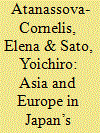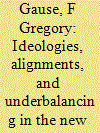|
|
|
Sort Order |
|
|
|
Items / Page
|
|
|
|
|
|
|
| Srl | Item |
| 1 |
ID:
187213


|
|
|
|
|
| Summary/Abstract |
This article examines Japan’s security alignments with key Asian and European partners, notably Australia, India, the UK, France and the EU itself. The articles explores Tokyo’s strategic expectations with regard to each of the five partnerships, as well as probing the likely future evolution of these alignments by providing a comparative perspective. Japan’s alignments with Australia and India conform with and supplement the US-Japan alliance, addressing Japan’s primary geostrategic concerns in the Asia-Pacific and the Indian Ocean region. Tokyo’s security partnerships with the European partners, and the EU, are more recent and not rooted in any US-led alliance in Asia. The degree of traditional kinetic military power these European players can bring to Asia is very limited. However, the pace with which Japan’s new European alignments are quickly moving beyond the non-traditional security areas to encompass more traditional defence and military-security fields attests to their potential of evolving in the future into mechanisms able to perform a broad range of security functions in response to complex security threats. The boundaries between these two categories of partnerships are likely to be further blurred, providing Japan with various mechanisms at different levels to shape and influence the regional and global security environment.
|
|
|
|
|
|
|
|
|
|
|
|
|
|
|
|
| 2 |
ID:
187210


|
|
|
|
|
| Summary/Abstract |
A reassessment the nature of “alliances” and “alignments” since the end of the Cold War, both practically and conceptually, is long overdue. Treaty alliances have become partially obsolescent as new models of security cooperation, such as the ‘strategic partnership’, and other “minilateral” configurations, have emerged as preferred instruments of alignment. The evolving nature of alliance and alignment is nowhere better illustrated than in the metamorphosis of the venerable Hub-and-Spokes US alliance system in the Indo-Pacific. This article captures the changes occurring in the US alliance system from both a macro-level (structural) standpoint, before proceeding to the micro-level to evaluate individual alliance/partnership dyads to illustrate the complexion of the hub-and-spokes “plus” configuration of today. It argues that we are witnessing is a “reshuffling of the deck” in terms of traditional treaty allies – with Japan and Australia now forming the “core” of the system, with South Korea effectively confined as a “single-issue” alliance focused on the peninsula, and with Thailand and the Philippines (arguably) becoming increasingly “peripheral”. But even as the original treaty-system contracts, Washington is seeking to “network” the original model through the acquisition of non-treaty strategic partnerships with key states such as India, Singapore, (and, more circumspectly – Taiwan), whilst also welcoming European engagement. This networking strategy is also designed to achieve second and third order effects through incentivisation of direct “spoke-to-spoke” security cooperation and through the concentration of allies/partners into minilateral formations. The resultant reconfiguration might be dubbed a Hub-and-Spokes “plus” model.
|
|
|
|
|
|
|
|
|
|
|
|
|
|
|
|
| 3 |
ID:
153946


|
|
|
|
|
|
|
|